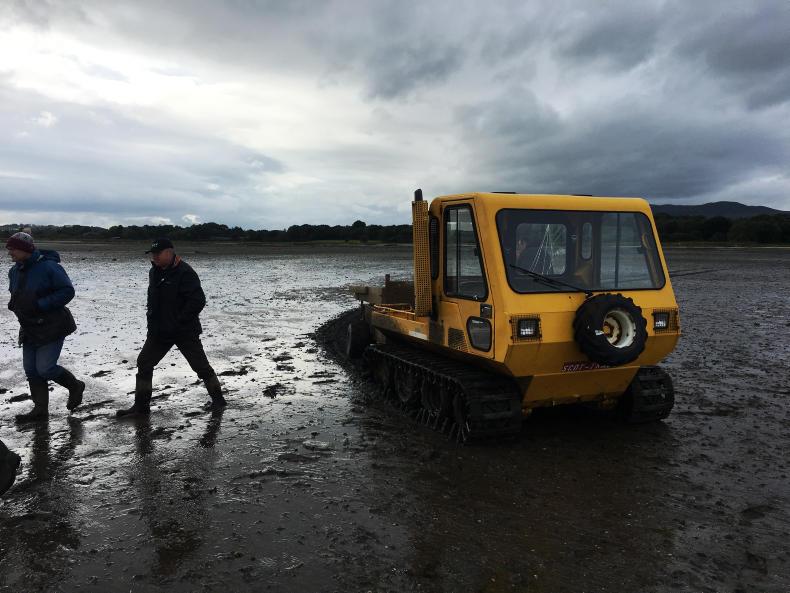My local suckler discussion group had its most recent meeting last week on the farm of one of our members, a close neighbour of mine.
The farmer in question is involved in a suckler-calf-to-beef system and has a substantial number of sheep on the farm as well.
However, as his land runs right up to the Foyle, he has, in the past couple of years, decided to try his hand at oyster farming as well.
The popularity of oyster farming has increased significantly
As he says himself, he decided to give it a go, partly to try to make some extra money and partly to stake a claim for the piece of the Foyle adjacent to his farm.
The popularity of oyster farming has increased significantly on the Foyle in recent years and if he hadn’t taken over and started farming this part of the river, someone else inevitably would have.
My knowledge of the technical side of oyster farming leaves a lot to be desired, but basically oyster seed arrives in the springtime in mesh-type sacks.
There are quite a few thousand seeds in each sack. These sacks are cable-tied on to metal trestles out on the bed of the river.

Oyster farming in Donegal. / James Strain
The tide then comes in and out over the oysters and they feed on plankton in the water.
The sacks must be turned and shaken up at some point during the summer, which apparently stimulates them into growing again.
Then, at this time of year, all the bags are taken in and the oysters are graded and divided up into smaller numbers to allow them to continue to grow.
I think it takes another full year before they are ready for harvest. Obviously not something every farmer can start up, but it was very interesting to get a look at. It’s always nice to see something different. I think everyone at the meeting thought the same.
Home farm
I vaccinated for scour and bolused my cows last week. I also decided to house 12 of the cows that are due to calve first.
There probably won’t be much happening for the next three weeks or so, but there’s nearly always something that goes early, so it's just easier to keep an eye on them in the shed.
It's also easier to keep an eye on their feed intake, as well as being able to get pre-calving minerals into them on a daily basis. If the recent spell of weather continues, it’s looking like they will have more company in the shed fairly soon.
Ground conditions are getting poor for heavy cows. There is plenty of grass around, but I’ll let the weanlings clean it up.
Read more
Farmer Writes: opportunities in poultry if carefully planned
Farmer Writes: deal or no deal - it's dusty
My local suckler discussion group had its most recent meeting last week on the farm of one of our members, a close neighbour of mine.
The farmer in question is involved in a suckler-calf-to-beef system and has a substantial number of sheep on the farm as well.
However, as his land runs right up to the Foyle, he has, in the past couple of years, decided to try his hand at oyster farming as well.
The popularity of oyster farming has increased significantly
As he says himself, he decided to give it a go, partly to try to make some extra money and partly to stake a claim for the piece of the Foyle adjacent to his farm.
The popularity of oyster farming has increased significantly on the Foyle in recent years and if he hadn’t taken over and started farming this part of the river, someone else inevitably would have.
My knowledge of the technical side of oyster farming leaves a lot to be desired, but basically oyster seed arrives in the springtime in mesh-type sacks.
There are quite a few thousand seeds in each sack. These sacks are cable-tied on to metal trestles out on the bed of the river.

Oyster farming in Donegal. / James Strain
The tide then comes in and out over the oysters and they feed on plankton in the water.
The sacks must be turned and shaken up at some point during the summer, which apparently stimulates them into growing again.
Then, at this time of year, all the bags are taken in and the oysters are graded and divided up into smaller numbers to allow them to continue to grow.
I think it takes another full year before they are ready for harvest. Obviously not something every farmer can start up, but it was very interesting to get a look at. It’s always nice to see something different. I think everyone at the meeting thought the same.
Home farm
I vaccinated for scour and bolused my cows last week. I also decided to house 12 of the cows that are due to calve first.
There probably won’t be much happening for the next three weeks or so, but there’s nearly always something that goes early, so it's just easier to keep an eye on them in the shed.
It's also easier to keep an eye on their feed intake, as well as being able to get pre-calving minerals into them on a daily basis. If the recent spell of weather continues, it’s looking like they will have more company in the shed fairly soon.
Ground conditions are getting poor for heavy cows. There is plenty of grass around, but I’ll let the weanlings clean it up.
Read more
Farmer Writes: opportunities in poultry if carefully planned
Farmer Writes: deal or no deal - it's dusty







 This is a subscriber-only article
This is a subscriber-only article











SHARING OPTIONS: